From year-round residents to uncommon migrants, Washington has many birds in its forests, mountains, and Pacific coastlines. And some of these species are brilliant blue-colored birds. Did you spot a flash of deep indigo on your hiking trek and wonder what it could be? Or do you have a beautiful sky-blue visitor to your feeder that you need help identifying? Discover all types of blue birds in Washington State to watch, including where they live and how to attract them to your yard.
1. Barn Swallow
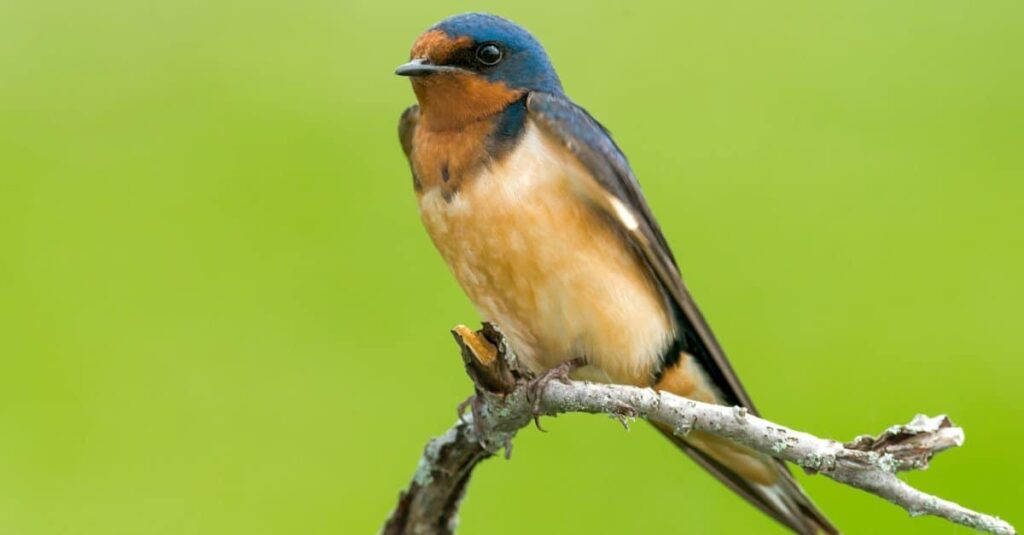
Barn swallows can be found around suburban parks.
©Paul Reeves Photography/Shutterstock.com
Watch the barn swallow glisten as it soars through the air over open fields. It is the most widespread swallow species on earth and has one of the most significant distributions of any passerine. They breed in the northern hemisphere and winter in the southern hemisphere, with a range across six continents. During the summer, you can find barn swallows in Washington around suburban parks, agricultural fields, and beaches. Their shiny cobalt bodies are unmistakable, featuring blue backs, wings, tails, and tawny undersides. This species doesn’t typically come to seed feeders but may stop by if you have ground-up eggshells in a platform feeder.
2. Blue Jay

The
blue jay
migrates to Washington in the winter.
©iStock.com/BrianEKushner
Blue jays are large passerine birds from the crow family native to the eastern United States. These common songbirds are most likely familiar to residents of North America, where they live year-round in oak trees in forested areas. However, they are not residents of Washington. They migrate to the state during winter, and scarce populations live in far eastern and western portions but are absent from central Washington. These crested birds have broad, rounded tails and feature shades of blue, black, white, and gray.
3. Indigo Bunting
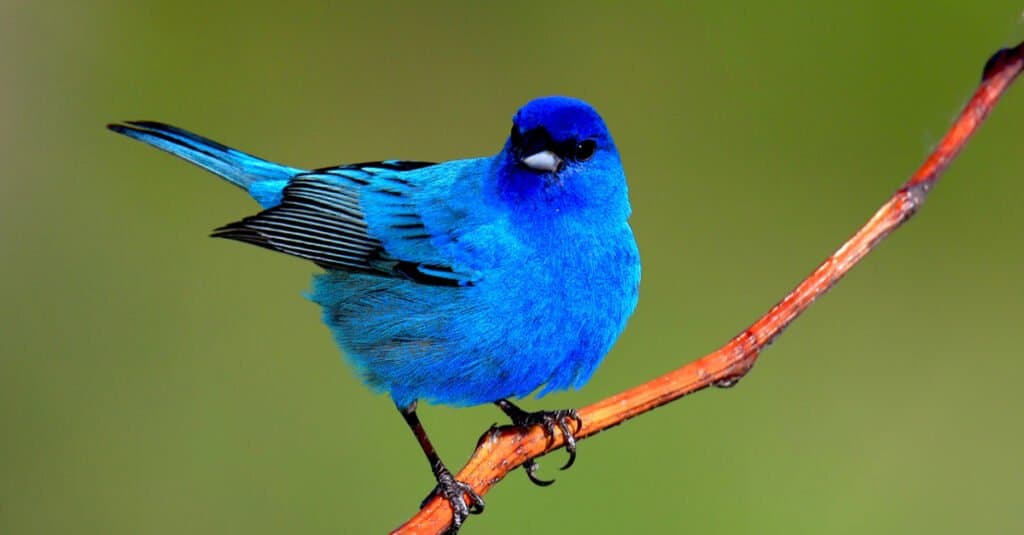
Indigo buntings enjoy small seeds.
©John L. Absher/Shutterstock.com
The indigo bunting is a brilliant all-blue small seed-eating bird from the cardinal family. They are migratory birds, ranging from Canada to the northern tip of South America, and reside primarily in the eastern half of the United States. But the indigo bunting is a rare visitor to Washington State, where they occasionally stop by state parks and wood edges. These stocky birds have short tails and thick bills and have blue plumage all over, with darker coloring on their heads. They also feature black streaks on their wings and tails. This species enjoys small seeds like thistle and nyger.
4. Belted Kingfisher
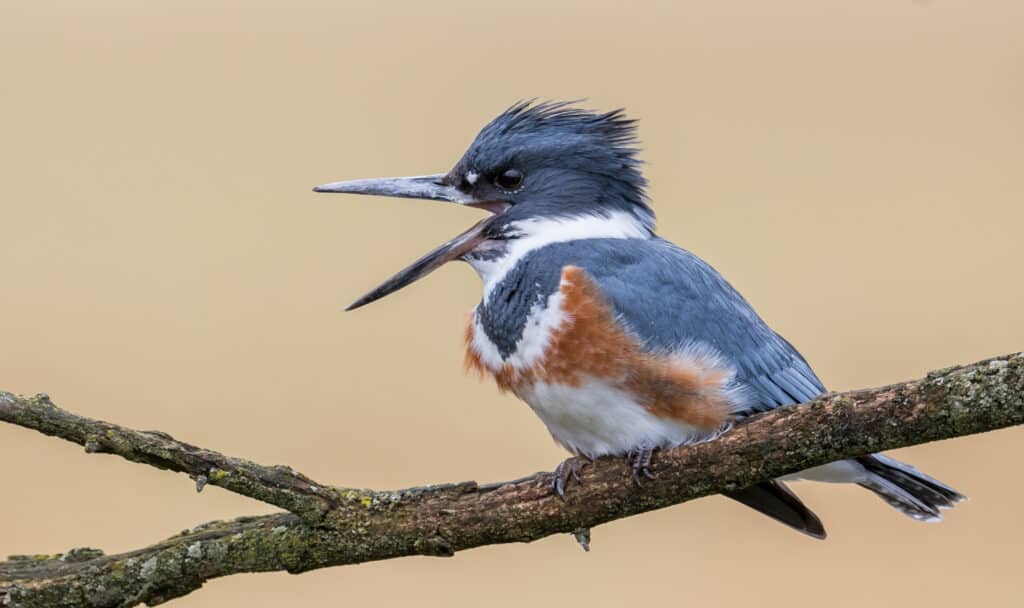
The belted
kingfisher
is colored blue.
©Harry Collins Photography/Shutterstock.com
Belted kingfishers are large, energetic water kingfishers native to North America. This species is both a resident and a migratory bird on the continent. Most populations in the United States are permanent in their environments. But those breeds in Canada migrate to the southwestern United States, Mexico, and Central America. They live year-round in Washington, and you can find them near streams, rivers, lakes, ponds, and estuaries. The belted kingfisher has a large head with a shaggy crest. It features bluish-grey plumage above and white below, with a white collar and a blue band across the chest.
5. California Scrub-Jay
The California scrub-jay is a medium-sized passerine from the crow family. This species has a limited range along the western coast of the United States. They live year-round in the southwestern portion of Washington State, where you can find them in scrub and oak woodlands and suburban yards near the ocean. They are more likely to visit if you have dense shrubs, sunflower seeds, and peanuts. This species is rich blue and gray above and white below.
6. Purple Martin
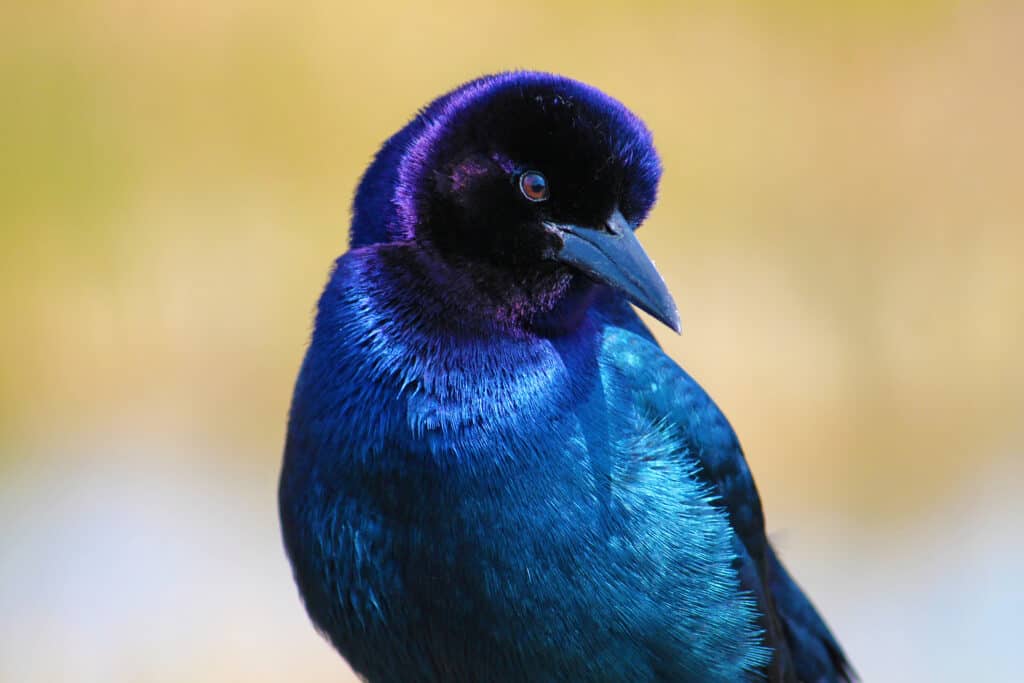
Purple martins have an average wingspan of 15 inches and a length of 7.9 inches.
©iStock.com/KennShapiro
The purple martin is the largest swallow in North America. Purple martins primarily live in the eastern half of the United States during breeding and flock together to migrate to South America for winter. But small breeding populations make their way to western Washington during summer; you can find them in cities, towns, parks, and open fields. Purple martins like birdhouses and will consume eggshells for digestion. Despite their name, these swallows are not purple. They are blackish-blue with an iridescent sheen and brown-black wings and tails.
7. Pinyon Jay
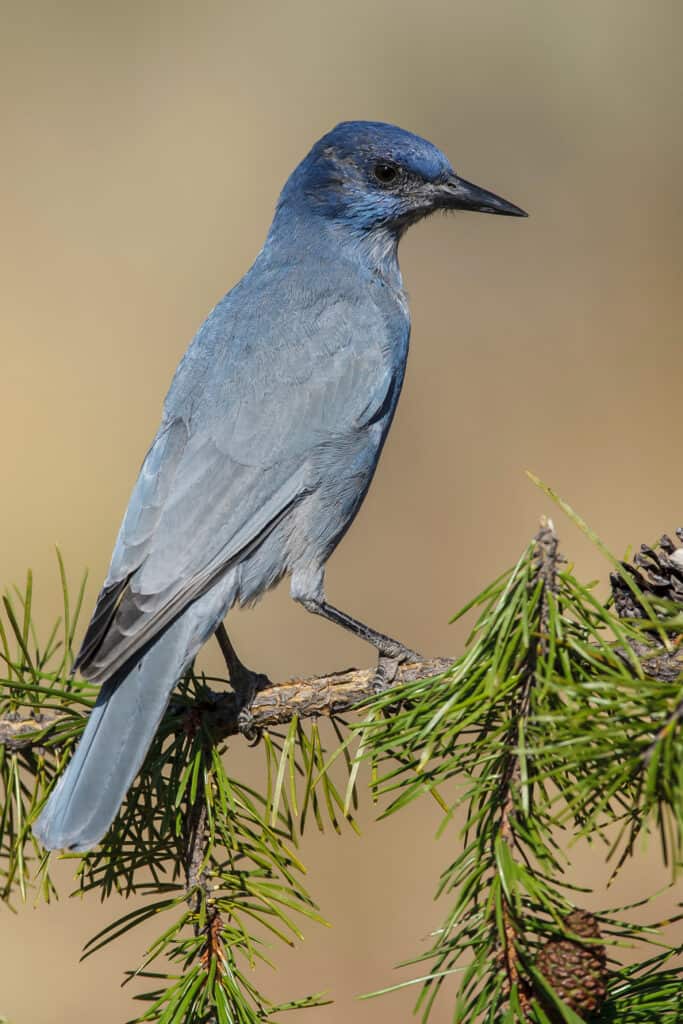
The pinyon jay looks similar to a small crow.
©Agami Photo Agency/Shutterstock.com
This crestless nomadic blue jay is native to the western United States, where they live year-round. They primarily inhabit the Great Basin region. But occasionally, non-breeding vagrants find their way to southern Washington and occupy pinyon-juniper woodlands and sagebrush. Pinyon jays will come to feeders for a quick bite if you leave out sunflower seeds, suet, and cracked corn. This species looks like a small crow and features dusky blue plumage, with gray bellies and white throats.
8. Tree Swallow
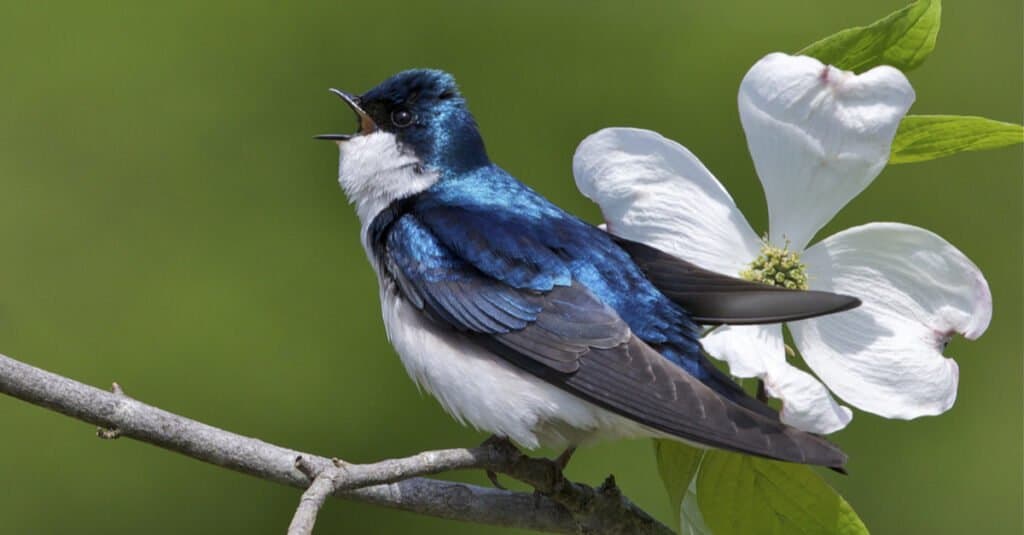
You can find tree swallows in marshes, fields and shorelines.
©Tom Reichner/Shutterstock.com
Tree swallows are glossy iridescent migratory birds from the Americas. They breed in Canada and the northern US, migrate through southern America, and winter in Mexico and Central America. You can find them throughout Washington during spring and summer, where they breed in marshes, fields, and shorelines. You can attract them to your yard by putting up a nest box and planting berry bushes. Tree swallows have streamlined bodies, long, pointed wings, and bluish-green plumage on their heads and upper bodies. They have white undersides and black wings, tails, and eye masks.
9. Steller’s Jay
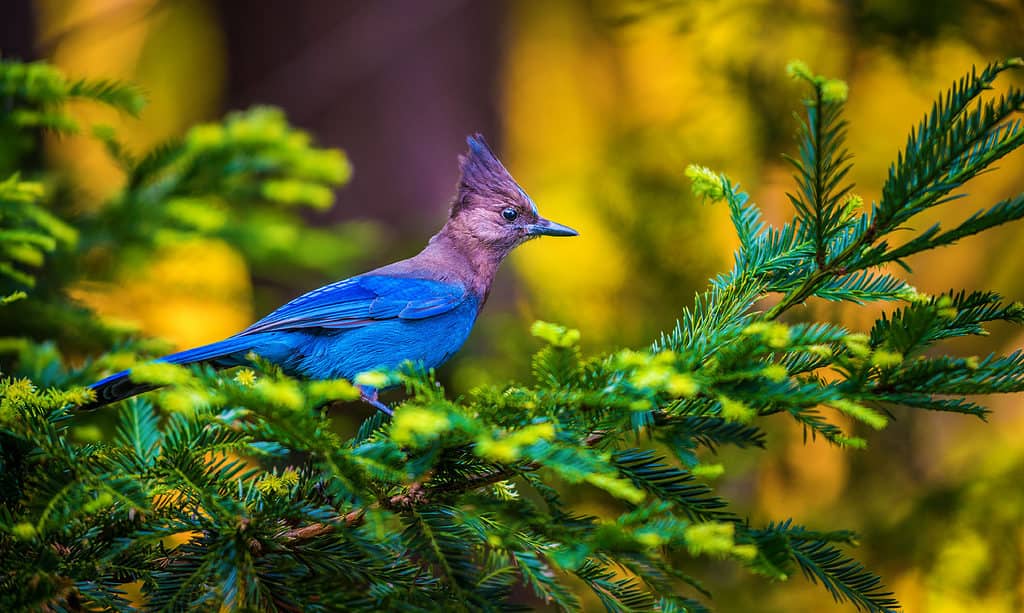
You can find the Steller’s jay in lower evergreen forests near the coastal foothills.
©iStock.com/kwiktor
The Steller’s jay is a large, dark-colored crested jay native to mountainous western North America. They live year-round in most of Washington, except for the central-southern region. You can find them in lower evergreen forests near the coastal foothills. You can attract them to your feeder by placing peanuts, large seeds, and nuts. These chunky jays have charcoal black heads and dark blue bodies that slightly lighten near the tails.
10. Red-Breasted Nuthatch

Red breasted nuthatches live year round in Washington.
©iStock.com/M. Leonard Photography
These energetic nuthatches are small songbirds with a widespread distribution across Canada and the United States. They live year-round in the western half of America, including Washington, where they primarily inhabit coniferous forests. The red-breasted nuthatch is a common visitor to feeders, and breeding pairs readily use nesting boxes. You can identify these birds by their compact blue-gray bodies, black and white streaked heads, and cinnamon-colored undersides.
11. Lazuli Bunting
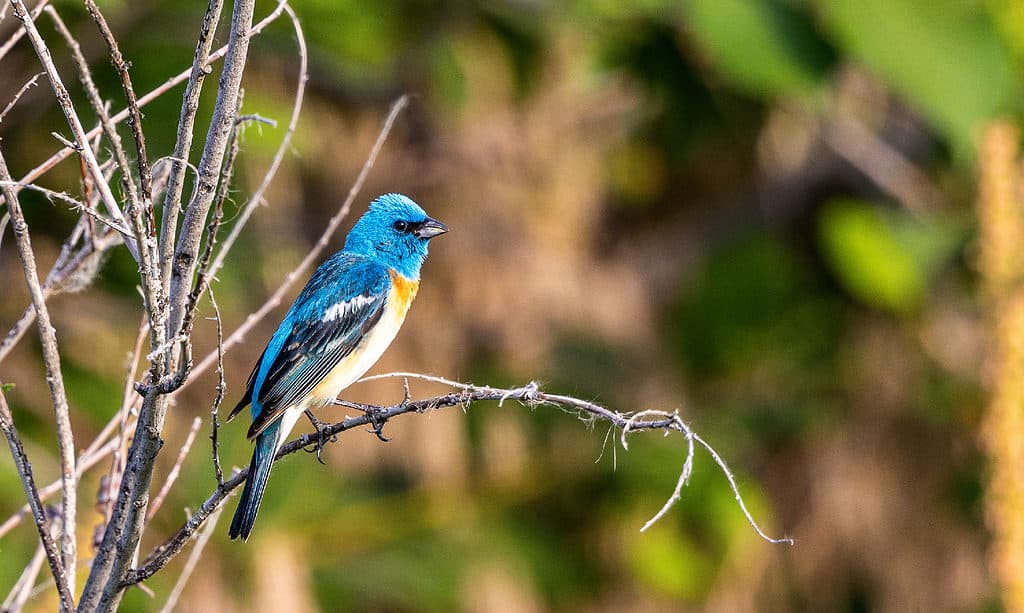
Lazuli buntings inhabit dry brushy hillsides and thickets throughout the western United States.
©iStock.com/Jeff Edwards
Named from the lapis gemstone, lazuli buntings feature brilliant blue plumage above, orange breasts, and white undersides. These buntings inhabit dry brushy hillsides and thickets throughout the western United States. They breed in America before heading to the Mexican coast for winter. This species stays across most of Washington, except for the far west near the coast. They are frequent visitors to bird feeders and prefer white proso millet, sunflower seeds, and nyjer thistle.
12. Rock Pigeon
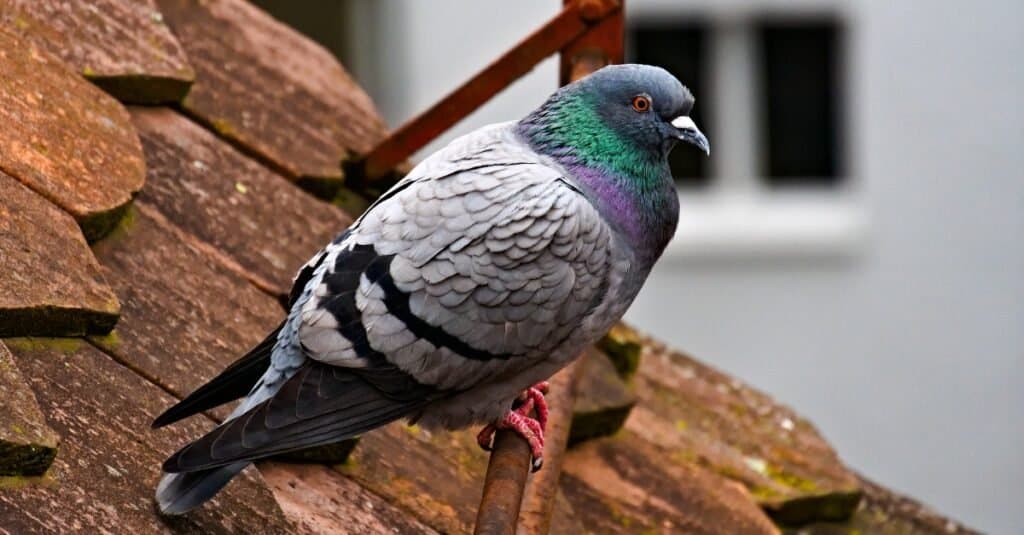
Rock pigeons live year round in Washington.
©iStock.com/Christian Sturzenegger
The rock pigeon, also known as the common pigeon, is a common and exceptionally widespread bird across North and South America, where they live year-round on both continents. Pigeons inhabit most cities across America, including those in Washington. Other than urban areas, you can find them on farmland and rocky cliffs. These birds prefer to forage for their food on the ground, so you can put out dried corn, peas, and sorghum to attract them to your property. The rock pigeon is large and plump, featuring bluish-gray plumage with an iridescent sheen.
13. Western Bluebird
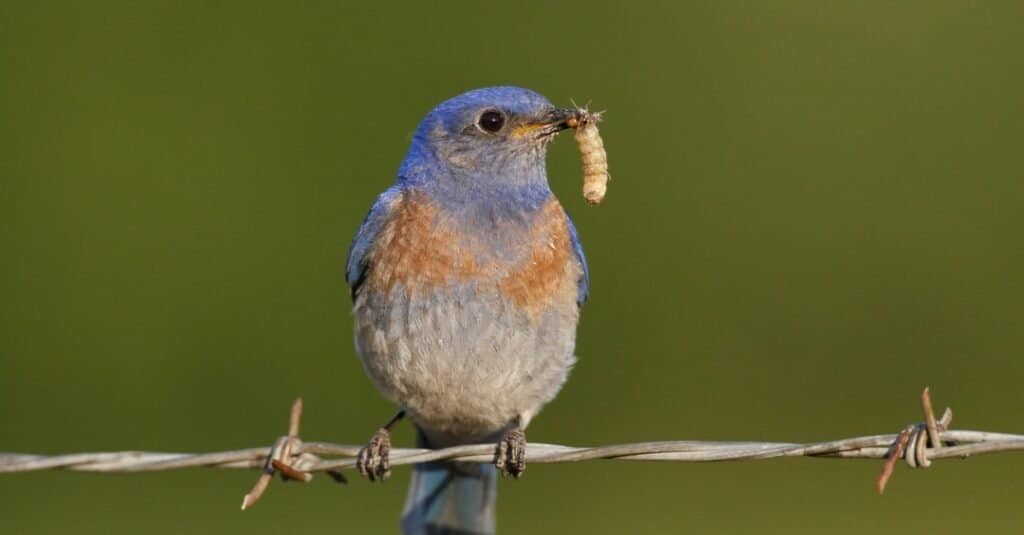
You can find western bluebirds living in open woodlands.
©iStock.com/mooninwell
Western bluebirds are bright blue with rust-colored breasts and white undersides. They inhabit the western United States and Mexico, where they have a patchy distribution. Scattered populations breed in central and eastern Washington, living in open woodlands or at the edges of woods. They also like to inhabit disturbed areas like burnt forests, where they nest in dead trees. These insectivores may visit your backyard if you provide meal worms and nest boxes.
14. Cliff Swallow

The cliff swallow builds its nest out of the mud on the side of cliffs or buildings.
©iStock.com/Kuhu
Cliff swallows are a familiar sight during hot American summers. They breed in the States and Canada before migrating to South America for the winter. They live all over Washington during spring and summer, and their preferred habitats include canyons, foothills, and river valleys. These compact swallows have broad, round wings and feature dark blue metallic-looking plumage on their heads and backs. They have white foreheads, chestnut or brick-red faces, and brownish-grey wings and tails.
Summary of the Types of Bluebirds in Washington
| Blue Bird | Scientific Name | |
|---|---|---|
| 1 | Barn Swallow | Hirundo rustica |
| 2 | Blue Jay | Cyanocitta cristata |
| 3 | Indigo Bunting | Passerina cyanea |
| 4 | Belted Kingfisher | Megaceryle alcyon |
| 5 | California Scrub-Jay | Aphelocoma californica |
| 6 | Purple Martin | Progne subis |
| 7 | Pinyon Jay | Gymnorhinus cyanocephalus |
| 8 | Tree Swallow | Tachycineta bicolor |
| 9 | Steller’s Jay | Cyanocitta stelleri |
| 10 | Red-Breasted Nuthatch | Sitta canadensis |
| 11 | Lazuli Bunting | Passerina amoena |
| 12 | Rock Pigeon | Columba livia |
| 13 | Western Bluebird | Sialia mexicana |
| 14 | Cliff Swallow | Petrochelidon pyrrhonota |
The photo featured at the top of this post is © iStock.com/Jeff Edwards
Thank you for reading! Have some feedback for us? Contact the AZ Animals editorial team.






